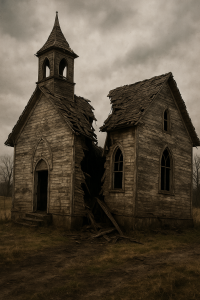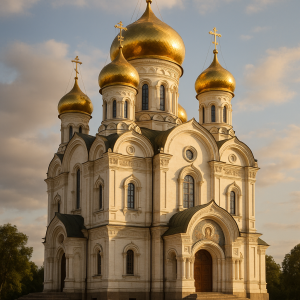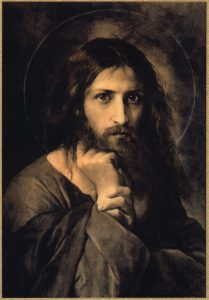The Eastern Orthodox Church is not a denomination, a sect, a branch, or a reimagining of early Christianity. She is the original Church founded by our Lord Jesus Christ, built upon the foundation of the Apostles and Prophets, Jesus Christ Himself being the chief Cornerstone (Ephesians 2:20). She is not a renovation, nor a restoration, for she has never collapsed. She is not a movement toward some ideal Church; she is the Church.
From Pentecost until the present hour, the Orthodox Church has preserved without alteration the fullness of the Apostolic Faith. She has neither added to the deposit once delivered to the saints (Jude 1:3), nor subtracted from it. Her councils are ecumenical, her doctrine is patristic, her worship is the unbroken continuation of the heavenly Liturgy. Her bishops stand in direct, physical, and spiritual succession from the Holy Apostles, and her sacraments are grace-filled mysteries, not symbolic gestures or human inventions.
All those who exist outside the canonical boundaries of the Orthodox Church, whether they be Protestant, Roman Catholic, or of another persuasion, are in a state of schism. This is not said with malice, but in solemn recognition of ecclesiastical reality. For the Church is not an invisible collection of sincere believers, nor a pluralistic fellowship of differing confessions. The Church is visible, sacramental, and hierarchical. She is the ecclesia—the called-out assembly—whose unity is not abstract, but made manifest in one faith, one baptism, and one Eucharistic communion (Ephesians 4:4–5).
As St. Irenaeus of Lyons wrote in the second century: “Where the Church is, there is the Spirit of God; and where the Spirit of God is, there is the Church and all grace.” And where the Church is not, neither is the fullness of the Spirit’s grace. The Orthodox Church does not claim exclusivity as an act of triumphalism, but in fidelity to Christ, who declared: “I will build My Church; and the gates of hell shall not prevail against it” (Matthew 16:18). This promise was not made to a loose network of groups, nor to future reformers, but to the Apostolic body which endures without rupture in the Orthodox Church.
The Church has never needed to be reinvented, for she has never been lost. She has never needed to reassert her identity, for her identity is sealed by the blood of the martyrs, the prayers of the saints, and the life-giving sacraments handed down without corruption. She is the Ark in the midst of the deluge, the Vineyard planted by the Lord, the Household of God on earth. To stand outside of her is to stand outside the apostolic communion which Christ Himself instituted.
The Eastern Orthodox Church is the One, Holy, Catholic, and Apostolic Church. All who are separated from her must return to her bosom, not to improve or correct her, but to be healed by her divine life. Unity with her is not a preference; it is a command of Christ. For there is “one body, and one Spirit, even as ye are called in one hope of your calling” (Ephesians 4:4). And that one Body is not to be found in fragments, but whole and entire, in the Orthodox Church alone.
 On the Wayward Path
On the Wayward Path
None of the following groups retained sacramental continuity with the historical Church. This is only a very small example of divisions.
- Lutheran Church – established in 1517
- Anabaptists/Mennonites – established 1525, 1536, 1693
- Church of England (Anglicanism) – established in 1534
- Reformed/Calvinist/Presbyterian Churches – established in 1536/1560
- Baptist Church – established 1609/1612
- Quakers – established in 1652
- Moravian Church – established in 1457/1722
- Seventh Day Baptist Church – established in 1671
- Methodist Church – established in 1738
- Unitarian Church – established in 1785
- Cumberland Presbyterian Church – established in 1810
- Churches of Christ/Disciples of Christ/Christian Church (Stone-Campbell Movement) – established in 1832
- Church of Christ (Non-Instrumental, from the Stone-Campbell Movement) – established in 1906
- Church of the Nazarene – established in 1908
- Assemblies of God – established in 1914
- Foursquare Church – established in 1923
- Southern Baptist Convention – established in 1845
- Seventh-day Adventist – established in 1863
- Jehovah’s Witnesses – established in 1932
- Worldwide Church of God – established in 1934
- United Pentecostal Church – established in 1945
- United Methodist Church – established in 1968
- Wesleyan Church – established in 1968
- Word of Faith Movement – established circa 1970s
- Evangelical Presbyterian Church – established in 1981
- Evangelical Lutheran Church in America – established in 1988
- United Church of God – split from the Worldwide Church of God, established in 1995
- The Potter’s House (T.D. Jakes) – established in 1996
- Liberation Methodist Connexion – established in 2020
- Unitarian Christian Alliance – established in 2020
- Global Methodist Church – split from United Methodist Church in 2022
The remarkable proliferation of divisions, sects, and denominations among Protestants is the natural consequence of certain foundational principles introduced at the time of the Reformation. While Protestants often appeal to the supposed purity of Scripture alone (sola Scriptura) and the priesthood of all believers, these very principles have historically functioned as engines of fragmentation rather than unity.
At the heart of Protestantism is the claim that the Bible alone is the supreme authority in matters of faith and practice. However, without a divinely guided and universally recognised interpretive authority (such as the episcopate of the undivided Church), this principle devolves into private judgment. Each individual, or each congregation, becomes the final arbiter of doctrine. This has led to a) conflicting interpretations of the same texts; b) the rise of self-appointed teachers and movements; and c) an absence of universally binding dogma.
The result is theological relativism disguised as biblical fidelity. One man’s “Spirit-led insight” becomes another’s heresy.
By severing themselves from the historical episcopacy and ecumenical councils, the Reformers eliminated the very means by which the early Church preserved doctrinal unity. Once apostolic succession was dismissed as unnecessary, any Christian with a Bible and conviction could start a church. Over time, this has yielded a) thousands of competing ecclesial bodies, often incompatible; b) no objective means for resolving theological disputes; and c) a deep suspicion of historical continuity.
This ecclesial atomisation has made Protestantism not a united body but a fluid and often contradictory association of doctrinal enclaves.
Many Protestant traditions, particularly Baptists and other Evangelical groups, embrace congregational polity, wherein each local church is entirely autonomous. While this ensures freedom from hierarchical control, it also facilitates division whenever disagreements arise. When conflict emerges—doctrinal, moral, or practical—splitting becomes the path of least resistance. Hence a) splits occur over some of the most minor issues; b) schisms beget further schisms; c) denominations proliferate into micro-denominations; and d) unity becomes a rhetorical ideal rather than a lived ecclesial reality.
 Protestantism has often allowed itself to be shaped by the prevailing political ideologies and cultural movements of the times. In the absence of a fixed magisterial structure, many denominations adapt their doctrine to contemporary pressures. For example: a) liberal denominations affirming moral relativism; b) conservative groups reacting into fundamentalism; and c) national churches becoming tools of the state.
Protestantism has often allowed itself to be shaped by the prevailing political ideologies and cultural movements of the times. In the absence of a fixed magisterial structure, many denominations adapt their doctrine to contemporary pressures. For example: a) liberal denominations affirming moral relativism; b) conservative groups reacting into fundamentalism; and c) national churches becoming tools of the state.
Such flexibility has rendered many Protestant bodies doctrinally unstable, with schisms forming whenever a segment of believers feels betrayed by the direction taken.
The Protestant world has long been animated by revivalist movements, often spearheaded by charismatic individuals claiming fresh revelation or deeper insight. These movements, while sometimes invigorating, often spiral into new sects, especially when personality cults develop or unorthodox doctrines arise. Jehovah’s Witnesses, Seventh-day Adventists, and Pentecostal sects all emerged in this manner. History has shown how prophetic movements often fracture internally and how theological innovation outruns ecclesial accountability. Each of these have created a spiritual marketplace where novelty is often mistaken for truth.
The multitude of sects and denominations in Protestantism is not an accident—it is the logical outworking of its foundational departures from the One, Holy, Catholic, and Apostolic Church. By rejecting the sacramental, conciliar, and episcopal unity of the ancient Church, Protestantism ensured that disunity would be not a momentary disorder, but its structural condition.
Where the early Church gathered in councils to guard the faith once delivered unto the saints (Jude 1:3), Protestantism gathers in conferences to redefine it. And so the divisions continue—not because truth is unknowable, but because the very structure of Protestantism lacks the means to secure it.
The Only Answer to Apostolic Unity
The answer to Christian unity is not found in well-meaning ecumenical gestures, interdenominational alliances, or negotiated statements of mutual tolerance. The true and enduring answer to unity is found only in the return to the fullness of the One, Holy, Catholic, and Apostolic Church—the Orthodox Church—preserved from the beginning by apostolic succession, conciliar authority, and sacramental life in the Holy Spirit.
True unity is doctrinal, not sentimental. As Saint Paul teaches, “Now I beseech you, brethren… that ye all speak the same thing, and that there be no divisions among you, but that ye be perfectly joined together in the same mind and in the same judgment.” (1 Corinthians 1:10) The Church is not a loose network of communities with divergent teachings—it is the pillar and ground of the truth (1 Timothy 3:15). Unity must therefore rest upon right doctrine (orthodoxy) and not upon emotional agreement or pragmatic alliances.
The Orthodox Church has preserved unbroken apostolic succession and adherence to the Holy Tradition received from Christ and the Apostles. It has never re-invented itself, never surrendered to modernist novelty, and never detached itself from the historic councils and the canonical structure of the undivided Church.
True unity is found where there is visible, historical, and theological continuity with the Church that gathered at Nicea, Ephesus, and Chalcedon—not in independent churches claiming invisible unity while teaching contradictory doctrines.
The Eucharist is the manifestation of the Church’s unity, not a tool for achieving it. The Fathers were unanimous. There is no true communion without agreement in faith. As Saint Ignatius of Antioch (c. 110 A.D.) said, “Take heed, then, to have but one Eucharist. For there is one flesh of our Lord Jesus Christ, and one cup unto unity of His blood; one altar, as there is one bishop.” (Epistle to the Philadelphians)
Modern Protestant attempts to share communion across doctrinal divisions are liturgical falsehoods. Only in the Orthodox Church, where the faith and sacramental life are united, is the Eucharist celebrated in true integrity.
 Christ prayed “that they all may be one” (John 17:21), but that unity is not vague or optional. The early Church did not negotiate with heresies; it called them to repentance and return. Likewise, the path to unity is not a fusion of traditions, but the return of the separated brethren to the Church that has never departed from the Apostolic Tradition. This is not triumphalism, but truth spoken in love. The Orthodox Church invites all—Catholics, Protestants, sectarians—to come home, not to an ethnic enclave or a nostalgic museum, but to the living Body of Christ.
Christ prayed “that they all may be one” (John 17:21), but that unity is not vague or optional. The early Church did not negotiate with heresies; it called them to repentance and return. Likewise, the path to unity is not a fusion of traditions, but the return of the separated brethren to the Church that has never departed from the Apostolic Tradition. This is not triumphalism, but truth spoken in love. The Orthodox Church invites all—Catholics, Protestants, sectarians—to come home, not to an ethnic enclave or a nostalgic museum, but to the living Body of Christ.
The answer to unity is not compromise, but faithfulness. The Orthodox Church alone preserves the fulness of the Apostolic Faith, the integrity of the sacraments, the unbroken line of bishops, and the conciliar mind of the Church. There will be no true Christian unity until all return to the one Ark of salvation—not invented by men, but founded by Christ, preserved by the Spirit, and recognised in the Orthodox Church. Anything less is counterfeit peace.

Comments are closed.